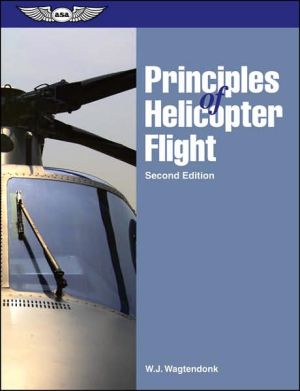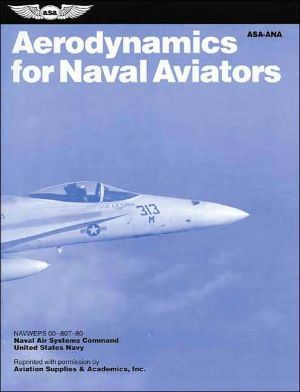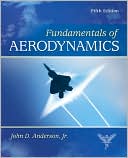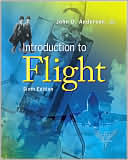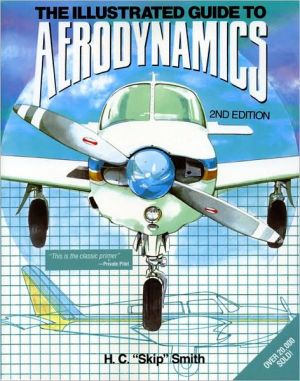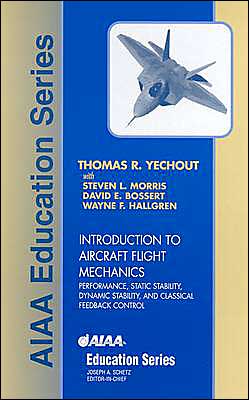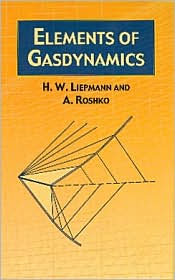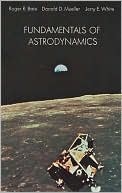Principles of Helicopter Flight
Recently updated, this comprehensive handbook explains the aerodynamics of helicopter flight, as well as how to perform typical helicopter maneuvers, unlike many aviation training manuals which are strictly how-to guides. Beginning with the basics of aerodynamics, each step of the process is fully illustrated and thoroughly explained—from the physics of helicopter flying and advanced operations to helicopter design and performance—providing helicopter pilots with a sound technical...
Search in google:
Recently updated, this comprehensive handbook explains the aerodynamics of helicopter flight, as well as how to perform typical helicopter maneuvers, unlike many aviation training manuals which are strictly how-to guides. Beginning with the basics of aerodynamics, each step of the process is fully illustrated and thoroughly explained—from the physics of helicopter flying and advanced operations to helicopter design and performance—providing helicopter pilots with a sound technical foundation on which to base their in-flight decisions. Containing discussions on the NOTAR (no tail rotor) system, strakes, and frequently misunderstood principles of airspeed and high-altitude operations, this revised edition also includes the latest procedures and regulations from the Federal Aviation Administration.
Foreword xiPreface xiiPhysics 1Newton's Laws 1Newton's First Law 1Newton's Second Law 2Newton's Third Law 3Conclusion 3Mathematical Terms 3Velocity 3Acceleration 3Equilibrium 4Gravitational Forces 4Centripetal Force 5Vector Quantities 5Moments and Couples 6Moments 6Couples 6Energy 6Pressure Energy 6Dynamic (Kinetic) Energy 7Units of Measurement 7Graphs 8Review 1 10The Atmosphere 11Atmospheric Pressure 11Air Temperature 11Combined Effects 12Moisture Content 12The Standard Atmosphere (ISA) 12Pressure Altitude 13Density Altitude 13Summary 13Operational Considerations 14Review 2 14Lift 15Definitions 15The Lift Formula 18Dynamic Energy 20Summary 20Indicated Airspeed and True Airspeed 21Center of Pressure 22Aerodynamic Center 24Review 3 26Drag 27Types of Drag 28Parasite Drag 28Profile Drag 29Form Drag 29Skin Friction 30Induced Drag 31Tip Vortices 33Effect of Airspeed on Induced Drag 34Effect of Aspect Ratio 34Methods to Reduce Induced Drag 35Wash-out 35Tip Design 35Total Drag Curve 36Conclusion 37Review 4 38Lift/Drag Ratio 39Best (or Maximum) L/D Ratio 40Other Factors Influencing L/D Ratio 41Conclusion 41Review 5 42Aerodynamic Forces 43Definitions 43Rotor Systems 45Introduction 45Rotational Airflow (Vr) 46Blade Angle of Attack 46Induced Flow 47Airflow Caused by Aircraft Velocity 48The Forces 48Total Rotor Thrust 49Rotor Drag (Torque) 49Angle of Attack and the Rotor Thrust/Rotor Drag Ratio 50Induced Flow and the Rotor Thrust/Rotor Drag Ratio 50Inflow Angle 51The Force Opposing Weight 52Factors Influencing Rotor Thrust 53Air Density 53Rotor rpm 54Blade Angle 54Disc Area 54Significant Aspects of High Inertia Blades 55Conclusion 55Review 6 56Rotor Blade Airfoils 57Drag Factors 57Stress Factors 58Effect of Local Air Velocity on Blade Design 59Blade Tip Speeds 59Development in Blade Design 60Review 7 60Rotor Drag (Torque) 61Disc Loading Changes 61Changes in Gross Weight 62Changes in Altitude 62Changes in Configuration 62Ground Effect 62Translational Lift 64Summary 65Review 8 66The Anti-Torque Rotor 67Anti-Torque Functions 67Mechanical Considerations 68Anti-Torque and Demand for Power 68Effect of the Wind 69Translating Tendency (Tail Rotor Drift) 70Rolling Tendency 71Tail Rotor Flapping 71Shrouded Tail Rotors 72Tail Rotor Design 72Other Methods of Anti-Torque Control 72Strakes and Anti-Torque 73Tail Rotor Failure 74Review 9 76Controls and Their Effects 77Collective Control 77Cyclic Control 78Effect of Controls on Blade Lead-Lag Behavior 78Mean Lag Position 78The Four Main Causes of Movement about the Lead/Lag Hinge 78Conservation of Angular Momentum (Coriolis Effect) 78Hookes Joint Effect 79Periodic Drag Changes 80Random Changes 80Review 10 80The Hover 81Hover Our-of Ground Effect (OGE) and In-Ground Effect (IGE) 81Factors Affecting Ground Effect 82Helicopter Height Above Ground Level 82Density Altitude and Gross Weight 82Gross Weight and Power Required 83Nature of the Surface 83Slope 83Wind Effect 84Confined Areas - Recirculation 84Factors Determining the Degree of Recirculation 84Over-Pitching 85Review 11 86Forward Flight 87Three Basic Aspects of Horizontal Flight 89Tilting the Disc with Cyclic 89An Alternate Explanation of Cyclic Action 91Dissymmetry of Lift 91Eliminating Dissymmetry of Lift 92Blow-Back (Flap Back) 94Blow-back (Flap-Back) When Using Collective 95Summary 96Designs that Reduce Flapping Amplitude 96Delta-3 Hinges 96Offset Pitch Horns 97Reverse Flow 98Translational Lift 99Transverse Flow Effect 101Review 12 102Power, Range and Endurance 103Power 103Ancillary Power 103Profile Power 103Induced Power 104Parasite Power 104The Total Horsepower Required Curve (the HPR) 105Attitude 106Weight 107Slingload and Parasite Drag Items 107Flying the Helicopter for Range 108Effect of the Wind 109Engine Considerations 110Range Summary 110Flying the Helicopter for Endurance 111Endurance Summary 111Review 13 112Climbing and Descending 113Climbing 113The Horsepower Available Curve (The HPA) 114Factors Affecting the Horsepower Available Curve 114Altitude 114Density Altitude 115Leaning the Mixture 115Collective Setting 115Rate of Climb 115Angle of Climb 116Effect of Lowering Horsepower Available Curve 116Summary 117Effect of the Wind 117Climb Performance Summary 118Descending 118Angle of Descent 119Effect of the Wind on Descents 120Descent Performance Summary 121Review 14 122Maneuvers 123Turning 123Rate of Turn 124Radius of Turn 125Rate and Radius Interaction 125The Steep Turn 125Power Requirement 126The Climbing Turn 127The Descending Turn 127Effect of Altitude on Rate of Turn and Radius of Turn 127Effect of Changes in Gross Weight on Rate and Radius 128Effect of the Wind on Rate and Radius 128Effect of the Wind on Indicated Airspeed and Translational Lift 129Effect of Slingloads 130Effect of Slipping and Skidding 131Pull-Out from a Descent 131Review 15 132The Flare 133Initial Action 133Flare Effects 133Thrust Reversal 134Increasing Total Rotor Thrust 134Increasing Rotor rpm 134Management of Collective 135Review 16 136Retreating Blade Stall 137Effect of Increasing Airspeed on Stall Angle 137Factors Affecting the Advancing Blade 138Symptoms of Retreating Blade Stall 138Recovery 139Factors Influencing V[subscript ne] 140Conclusion 141Review 17 142Autorotation 143Initial Aircraft Reaction 143The Lift/Drag Ratio and Forces Involved 143The Stalled Region 144The Driven (Propeller) Region 145The Driving (Autorotative) Region 145Combined Effects of All Regions 146Autorotation and Airspeed 148Combined Effect 149Effect of Forward Speed on the Three Regions 150Effect of Airspeed Changes on Rotor rpm 150Autorotation Range and Endurance 150Effect of Altitude on Range and Endurance 151Effect of Gross Weight on Range and Endurance 151Effect of Parasite Drag and Slingloads on Range and Endurance 152Touchdown 152Loss of Power at Low Heights 153Factors Influencing Rotor rpm Decay When the Engine Fails 153Combination of Airspeed and Height Best Avoided 153Review 18 156Hazardous Flight Conditions 157Vortex Ring State 157Effect on the Root Section of the Blade 158Effect on the Tip Section of the Blade 158Flight Conditions Likely to Lead to Vortex Ring State 160Symptoms of Vortex Ring State 160Recovery from Vortex Ring State 161Tail Rotor Vortex Ring State 161Ground Resonance 162Causes of Ground Resonance 162Factors that May Cause Ground Resonance 163Rotor Head Vibrations 163Fuselage Factors 163Ground Resonance Recovery Action 164Blade Sailing 164Dynamic Rollover 165Factors Influencing the Critical Angle 165Cyclic Limitations 166Mast Bumping 167Avoiding Mast Bumping 169Recovery from Low and Zero g 169Mast Bumping Summary 169Exceeding Rotor rpm Limits 169Reasons for High Rotor rpm Limits 169Engine Considerations 169Blade Attachment Stress 169Sonic Problems 170Reasons for Low Rotor rpm Limits 170Insufficient Centrifugal Force 170Reduced Tail Rotor Thrust 170Rotor Stalls 170Recovery from Low Rotor rpm 171Review 19 172Helicopter Design and Components 173Transmission 173Main Rotor Gear Box 173Freewheeling Unit 174Drive Shafts 174Tail Rotor Gear Box 174Rotor Brake 174Clutch 174Chip Detectors 175Governors 175Swashplate (Control Orbit) 176Phase Lag 177Advance Angle 177Rotor Blades 179Chordwise Blade Balancing 180Spanwise Blade Balancing 180Trim Controls 180Bias Control 180Electronic Servo Systems 180Tail Rotors 181Tail Rotor Flapping 181Tail Rotor Rotation 181Helicopter Vibrations 181Types of Vibrations 182Vertical Vibrations 182Lateral Vibrations 183Combined Vertical and Lateral Vibrations 183High Frequency Vibrations 183Engine Vibrations 184Remedial Action by the Pilot 184Control Functions 184Collective 184Twist Grip Throttle 184Engine Cooling 185Carburetor Icing 185Dual Tachometer Instruments 186Rotor Stabilizing Design Systems 187The Bell Stabilizing Bar 187The Hiller System 187The Underslung Rotor System 188Rotorless Anti-Torque System 189Advantages of the Notar System 189Components 189Air Intake 190Engine-driven Fan 190Slots 190Direct Jet Thruster 191Vertical Stabilizers 191Undercarriages 192Skids 192Wheels 192Oleo (Shock) Struts 193Review 20 195Stability 195Static Stability 195Dynamic Stability 195Stability in the Three Planes of Movement 196Longitudinal Stability 197Longitudinal Stability Aids 197Lateral Stability 198Directional Stability 199Directional Stability Aids 200Cross Coupling with Lateral Stability 200Offset Flapping Hinges 200Review 21 202Special Helicopter Techniques 203Crosswind Factors 203Lateral Blow-back (Flap-back) 203Weathervane Action 203Effect on tail Rotor Thrust 203Different Types of Takeoffs and Landings 204Downwind Takeoffs and Landings 204Running Takeoff 204Cushion-Creep Takeoff 205Confined Area Takeoff (Towering Takeoff) 205Maximum Performance Takeoff 206Running Landing 206The Zero-Speed Landing 207Operations on Sloping Surfaces 207Sling Operations 208The Equipment 208The Sling 210Ground Handling 211Flying Techniques 212Snagging of Cable or Strap on the Undercarriage before Liftoff 212Never-Exceed Speed (V[subscript ne]) 213Preflight Rigging 213Length of Cable or Strap 213Number and Type of Slings 213Nets 213Pallets 214Load Center of Gravity 214Pilot Action in Case of Helicopter Oscillation 214The Approach 215Types of Slingload 215Horizontal Loads 215Unusual Loads 216Conclusion 219Review 22 220Mountain Flying 221Updrafts and Downdrafts 221Thermal Currents 223Katabatic and Anabatic Winds 224Mechanical Turbulence 224Wind Strength 225Size and Shape of Mountains 226Stability or Instability of Air 226Wind Direction Relative to Mountain Orientation 227Summary 227Valley Flying 227Ridgeline Flying 228The "Standard" Mountain Approach 228General Coinments on Mountain Approaches 230High Attitude Approach Considerations 230Transition 232Ground Effect Considerations on Mountain Sites 232Determining Wind Change during Critical Phases 233Landing Site Selection 233Surface of Sites 233Flight in Areas Covered in Snow and Ice 234Survival Equipment 235Review 23 236Helicopter Icing 237Ice Accretion 237Influence of Temperature and Drop Size 237Water Content of Air 238Kinetic Heating 238Shape of Airfoils and Other Aircraft Components 238Mechanical Flexion and Vibration 239Ice Formation on Blades at Different Temperatures 239Electrical Anti-Icing 240Consequences of Ice Accretion 240Engine Intake Icing 241Review 24 242Helicopter Performance 243Helicopter Performance Factors 243Altitude 243Pressure Altitude 244Density Altitude 246Combined Effect of Pressure and Density Altitude 247Moisture Content of Air 248Aircraft Gross Weight 248External Stores 248The Wind 249Power Check 249Performance Graphs 250Units of Measurement 251Hover Ceiling Graph 252Takeoff Distance over a 50-Foot Obstacle 254Turbine Engine Power Check 256Maximum Gross Weight for Hovering 258Climb Performance 260Range 261Endurance 262Review 25 263Weight and Balance 265Definitions 265Weight 267Balance 267Beyond the Center of Gravity Limits 268Excessive Forward Center of Gravity 268Excessive Aft Center of Gravity 269Summary 269Calculating the Center of Gravity Position 269To Calculate the Longitudinal Center of Gravity Position 271To Calculate the Lateral Takeoff Center of Gravity Position 271Summary 273Effect of External Loads on Center of Gravity Position 273Conclusion 274Review 26 274Sample Examination 277Temperature Conversion 287Altimeter Setting Conversion 289Review and Examination Answers 291Glossary 295Index 299
